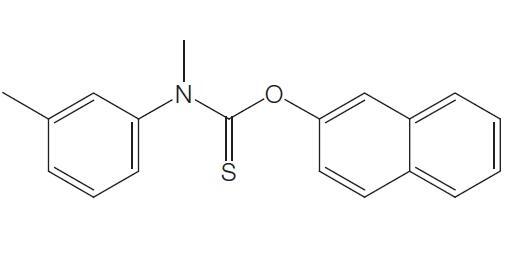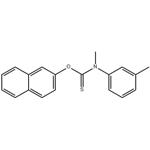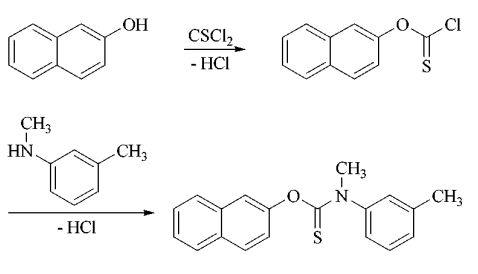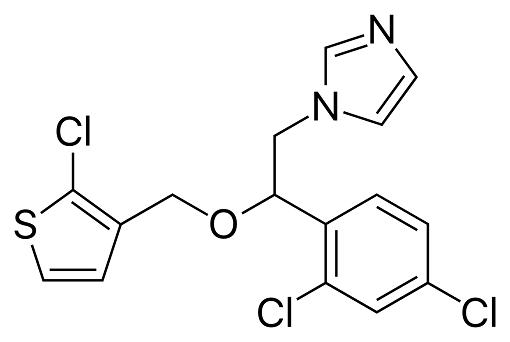Mechanism of action of Tolnaftate
Tolnaftate is an old synthetic topical thiocarbamate antifungal agent with the chemical name 2-naphthyl N-methyl-N-(3-tolyl)thlonocarbamate; the chemical structure is shown below. Clinical use of tolnaftate has declined with the introduction of more potent antifungal compounds such as terbinafine and naftifine.

Uses
Tolnaftate is used primarily for the treatment of mild to moderate tinea pedis, tinea cruris, tinea corporis, and tinea versicolor. It is not indicated for the treatment of onychomycosis due to the lack of drug penetration through the nail plate. Tolnaftate has been successfully used in the treatment of fungal otitis externa; however, it is not recommended for the treatment of serious fungal infections.
Mechanism of action
Like naftifine and terbinafine , tolnaftate is a reversible and noncompetitive inhibitor of fungal squalene epoxidase. The blockade of this enzyme results in the accumulation of squalene and a deficiency of ergosterol, the major component of fungal cell membrane.
In T. mentagrophytes cells, tolnaftate has been shown to cause a dosedependent inhibition of ergosterol biosynthesis and accumulation of squalene. Complete inhibition was achieved at concentrations of 0.1 mg/ml. In contrast, the activity of tolnaftate against C. albicans and C. parapsilosis was notably lower, and incomplete inhibition was achieved only at concentrations of 100 mg/ml. The activity of tolnaftate on sterol biosynthesis was enhanced in a cell-free system of C. albicans, suggesting that tolnaftate might be unable to diffuse into the cell envelope of Candida spp. The comparative potency of the thiocarbamates and allylamines for the microsomal squalene epoxidase of T. rubrum and C. albicans was explained by the affinity of the antifungal agents for the squalene epoxidase.
In this regard, tolnaftate has a much higher specificity for the T. rubrum squalene epoxidase than for the enzyme of C. albicans.
Dosage
Tolnaftate is available as a 1% lotion, cream, aerosol spray, and powder. For tinea pedis and tinea cruris, 1% cream, solution, or powder is applied twice daily for 2–6 weeks. It is recommended that tolnaftate application should be extended at least 2 cm beyond the visible edge of the tinea lesion, and the cream or lotion should be rubbed gently into the area.
Uses
Tolnaftate 1% cream applied twice daily for 3 or 4 weeks is as effective as clotrimazole 1% cream for the treatment of tinea pedis, tinea corporis, and tinea cruris due to T. rubrum, T. mentagrophytes, and E. floccosum. Mycologic eradication was demonstrated in 93% of tolnaftate-treated patients and clinical cure was achieved in 53–70% of patients in small studies. No relapse was documented in the 4 weeks' follow-up treatment.
Equivalent mycologic and clinical efficacy (65–70%) was documented for tolnaftate 1% cream, 3% undecylenic acid, and 20% zinc undecylenate as a cream. A randomized, controlled study comparing 10% tea tree oil cream, 1% tolnaftate cream, and placebo in the treatment of tinea pedis showed similar clinical efficacy with tea tree oil and tolnaftate; however, 1% tolnaftate cream was significantly more effective in achieving a mycologic cure (85% mycologic cure in the tolnaftate arm versus 30% in the tea tree oil arm).
Side effects
Skin irritation and contact dermatitis have been rarely reported.
Related articles And Qustion
See also
Lastest Price from Tolnaftate manufacturers

US $0.00/kg2025-11-21
- CAS:
- 2398-96-1
- Min. Order:
- 1kg
- Purity:
- 98%
- Supply Ability:
- Customise

US $5.00-0.50/KG2025-05-07
- CAS:
- 2398-96-1
- Min. Order:
- 1KG
- Purity:
- 99% hplc
- Supply Ability:
- 500TONS



